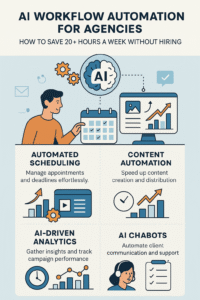AI Workflow Automation for Agencies: How to Save 20+ Hours a Week Without Hiring

Introduction: The Burnout Bottleneck
Emma, the founder of a boutique digital agency, found herself working 14-hour days. Despite having a talented team, she was overwhelmed by repetitive tasks: manual client onboarding, drafting proposals, and generating reports. The workload was unsustainable, and hiring more staff wasn’t financially viable.
This scenario is common among solopreneurs, freelancers, and small business owners. The solution? AI workflow automation for agencies. By automating routine tasks, agencies can reclaim valuable time and focus on strategic growth.
What Is AI Workflow Automation and Why Agencies Need It Now
AI workflow automation involves using artificial intelligence to streamline and automate business processes. For agencies, this means:
-
Time Savings: Automating repetitive tasks frees up hours each week.
-
Cost Efficiency: Reduces the need for additional hires.
-
Scalability: Processes can handle increased workloads without extra resources.
-
Consistency: Ensures tasks are performed uniformly, reducing errors.
Incorporating AI into workflows isn’t just a trend; it’s a strategic move to enhance productivity and competitiveness.
Common Agency Tasks That Can Be Automated Today
Agencies can leverage AI to automate various tasks:
-
Lead Generation & Qualification: AI tools can identify and prioritize potential clients.
-
Client Onboarding: Automated systems can handle documentation and initial communications.
-
Social Media Management: Schedule posts and analyze engagement metrics automatically.
-
Reporting and Analytics: Generate client reports with real-time data insights.
-
Email Campaigns: Automate personalized email sequences for marketing.
-
Proposal and Contract Generation: Use templates and AI to draft documents quickly.
By automating these areas, agencies can focus more on creative and strategic initiatives.
Top AI Tools Every Agency Should Use in 2025
To implement AI workflow automation effectively, consider these tools:
-
CRM & Automation: HubSpot, GoHighLevel
-
Content Creation: Copy.ai, Jasper
-
Social Media Automation: Buffer, Ocoya
-
Workflow Automation: Zapier, Make (Integromat)
-
Chatbots & Lead Capture: ManyChat, Tidio AI
These tools can be integrated into existing systems to enhance efficiency and output.
Real-World Case Study: How One Agency Saved 30 Hours/Week
Consider a mid-sized marketing agency that implemented AI workflow automation:
-
Challenge: Time-consuming manual reporting and client communications.
-
Solution: Integrated Zapier to automate data collection and report generation; used ManyChat for automated client interactions.
-
Outcome: Saved 30 hours per week, allowing the team to focus on strategy and client acquisition.
This transformation showcases the tangible benefits of embracing AI automation.
How to Audit Your Current Workflow for Automation Opportunities
To identify areas ripe for automation:
-
List Daily Tasks: Document all routine activities.
-
Identify Repetitive Tasks: Highlight tasks that are time-consuming and repetitive.
-
Evaluate Complexity: Determine which tasks follow a set pattern or rules.
-
Assess Impact: Consider the time saved and potential errors reduced by automating each task.
-
Prioritize: Focus on automating tasks with the highest time investment and error rates.
This audit will provide a clear roadmap for implementing AI automation effectively.
A Step-by-Step AI Workflow Setup for Agencies
Implementing AI workflow automation involves:
-
Select a Task: Choose a repetitive task to automate.
-
Choose the Right Tool: Select an AI tool suited for the task.
-
Design the Workflow: Map out the steps the AI will perform.
-
Test the Automation: Run the workflow to ensure it functions correctly.
-
Monitor and Optimize: Regularly review the automation for improvements.
Starting with one task allows for manageable implementation and adjustment.
Mistakes to Avoid When Automating Agency Workflows
Common pitfalls include:
-
Over-Automation: Automating tasks that require human judgment can lead to errors.
-
Neglecting Oversight: Failing to monitor automated processes can result in unnoticed issues.
-
Ignoring Team Input: Not involving team members can lead to resistance and underutilization.
-
Lack of Training: Without proper training, staff may misuse or underuse automation tools.
Avoiding these mistakes ensures a smoother transition to automated workflows.
How AI Enhances Client Experience (Not Just Internal Efficiency)
AI automation doesn’t just benefit internal operations; it also enhances client interactions:
-
Faster Response Times: Automated systems can handle inquiries promptly.
-
Personalized Communications: AI can tailor messages based on client data.
-
Consistent Updates: Clients receive regular updates without manual input.
-
Improved Accuracy: Reduced human error leads to more reliable information.
These improvements can lead to higher client satisfaction and retention.
Conclusion: Your Next Move Toward a Leaner, Smarter Agency
Embracing AI workflow automation for agencies is no longer optional—it’s essential for staying competitive. By automating repetitive tasks, agencies can save time, reduce costs, and enhance client satisfaction.
Take Action:
-
Conduct a Workflow Audit: Identify tasks suitable for automation.
-
Select Appropriate AI Tools: Choose tools that align with your agency’s needs.
-
Implement Automation Gradually: Start with one task and expand.
-
Train Your Team: Ensure everyone understands and can use the new systems.
-
Monitor and Refine: Continuously assess and improve automated workflows.
By following these steps, your agency can become more efficient, scalable, and client-focused.
✅ Your Next Step:
Pick one AI tool. Automate one task. Save your first hour.
Ready to take the first step? Grab our free AI Toolstack PDF or explore our “Prompt Pack for Creators” to get started today.